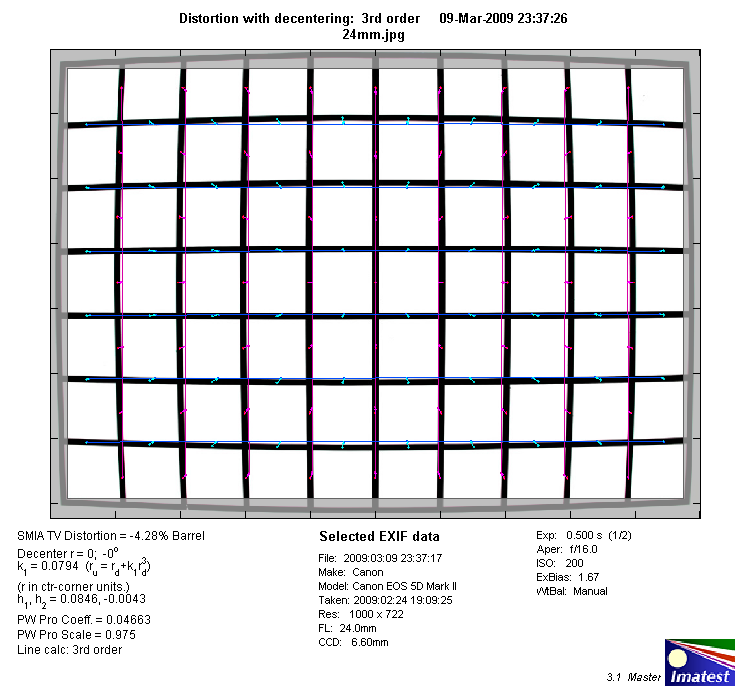|
Canon EF 24-105mm f/4 USM L IS (full format) - Review / Lab Test Report - Analysis |
|
Lens Reviews -
Canon EOS (Full Format)
|
|
Page 2 of 2

Distortion
The lens produces massive barrel distortion of 4.3% at 24mm - this is highly disturbing for architecture photography or scenes with straight lines unless you correct the effect during post-processing. The situation eases soon thereafter and the lens reaches its lowest degree of distortion at 40mm (~0.7%). The problem increases again towards the long end of the range but the local pincushion distortion remains acceptable at around 1.5%.
|
Move the mouse cursor over the focal length text marks below to observe the respective distortion
|
| 24mm |
40mm |
70mm |
105mm |
|

|
The chart above has a real-world size of about 120x80cm.
Vignetting
This is a lens test based on a full format DSLR and these cameras tend to amplify vignetting problems - the EF 24-105mm f/4 USM L IS has surely its share of problems here specifically at 24mm where we can see a whopping vignetting of ~2.5EV at f/4 which is easily visible in field conditions. The problem is remains very pronounced at f/5.6 and it's still quite high at f/8 and f/11 (1-1.25EV). However, the latter is acceptable on a full format DSLR where the dynamic range is broad enough to correct such problems without running into significant side effects. The vignetting isn't quite as extreme at other focal lengths although it makes sense to stop down a little in critical scenes.

MTF (resolution)
The EF 24-105mm L produced decent resolution figures in the MTF lab. At the wide end of the zoom range the center performance can reach very good to excellent levels followed by very good borders and good to very good extreme corners. Unfortunately the situation isn't quite as impressive at 70mm - the center performance remains very high but the border quality is soft at max. aperture so it's better to stop down to f/5.6 or preferably f/8 if you need a more even quality distribution across the frame. At 105mm the border quality recovers at max. aperture although it does still improve somewhat at medium aperture settings. The lens suffered a bit from field curvature and the lens alignment (centering) wasn't perfect at the long end of the range (still within test specifications).
Please note that the MTF results are not directly comparable across the different systems!
Below is a simplified summary of the formal findings. The chart shows line widths per picture height (LW/PH) which can be taken as a measure for sharpness.
If you want to know more about the MTF50 figures you may check out the corresponding Imatest Explanations
Chromatic Aberrations
Lateral chromatic aberrations (color shadows at harsh contrast transitions) are no deal breaker - they remain on a comparatively moderate level at all focal lengths. Typical for most standard zoom lenses they're most pronounced at 24mm averaging around 1.5px at the image borders, it's slightly less at other focal lengths. This is naturally visible when observing an image at 100% magnification on a screen but it's a lesser issue on prints unless you go for the extremes here. Lateral CAs are also easily correctable during post-processing (Canon's DPP does it for you for instance).

Bokeh (out-of-focus blur) @ 105mm
The Canon EF 24-105mm L is capable of producing a pleasing bokeh for a zoom lens. The circular out-of-focus highlights show a slight halo effect at 105mm f/4. Stopping down to f/5.6 reduces the effect but it's not overly worrisome anyway. The out-of-focus blur is very smooth and nothing to worry about (at 105mm). However, regarding its rather moderate max. aperture the 24-105mm L isn't really suitable for shallow depth-of-field applications.

Verdict
The Canon EF 24-105mm f/4 USM L IS is surely one of the better standard zoom lenses for full format EOS DSLRs but it's not perfect within this scope nonetheless. The resolution figures are generally very decent except for a pronounced border softness at 70mm @ f/4. Neither distortions nor vignetting are something to rave about at 24mm although these are no real issue at other focal lengths. Lateral CAs can be visible at times but the problem is generally well controlled (relative to other lenses in its class). The quality of the bokeh (@ 105mm) is very usable - within the limits of a lens with a moderate max. aperture. As to be expected from a modern Canon L lens the construction quality is up to pro standards. The AF is exceptionally fast, accurate and near silent. The image stabilizer works well within its specifications although some may miss a panning mode which is implemented in Canon's IS L tele lenses. The EF 24-105mm is a pricey lens but also a substantial one.
|